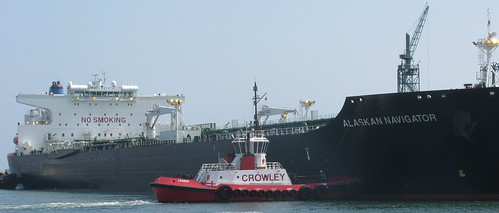California notches another world 1st in its environmental campaign – This time with a plug-in oceanliner!
(Source: Revenge of the Electric Car & LA Times)
It’s been a long time coming, but we have finally achieved the first “cold ironing” of a tanker in the Port of Long Beach. Cold Ironing is the term for plugging a ship’s electrical system into the on-shore grid to supply power so that the ship’s giant diesel engine can be turned off while it’s docked. Normally, these engines crank out massive amounts of pollution, equal to “a day’s worth of driving by 187,000 cars,” according to estimates by the Port of Long Beach.
Port of Long Beach takes ‘giant step’ toward pollution reduction Port officials unveil what is billed as the world’s first electrical shore-side power system for tankers, which are notorious fuel guzzlers and air polluters. Docked in Long Beach on Wednesday with a fresh load of oil from Valdez, the Alaskan Navigator didn’t look like much of a trailblazer.

The massive tanker sat silently, with a few thin cables draping down to some gray metal boxes. Missing was the incessant rumble of diesel engines, which on an average cargo ship would be running constantly to keep electrical systems going — burning quite a bit of diesel fuel and generating a significant amount of pollution. But the 941-foot Navigator, anchored at the BP oil terminal’s Pier T on the Long Beach port’s main channel, isn’t average. The vessel, owned by Alaska Tanker Co. of Portland, Ore., was plugged into what is billed as the world’s first shore-side electrical grid.
The project cost $23.7 million and took three years to complete, port officials said. The port contributed about $17.5 million to the project and BP paid the rest. One project partner noted that the emissions reductions amounted to 50% even when factoring in pollution created by power plants in generating the electricity.
The Natural Resources Defense Council (NRDC) initiated suits against the ports over seven years ago to make this happen, and it was a long difficult fight, but the NRDC’s attorneys persevered and eventually won. This event marks the first of what we hope will be the electrification of all the tanker and cargo ships while docked in the ports of Los Angeles and Long Beach (and probably worldwide?). For too long, the people living downwind of the ports have suffered the ill effects of this pollution with heart and lung disease, cancers and asthma rates that are significantly higher than average.




